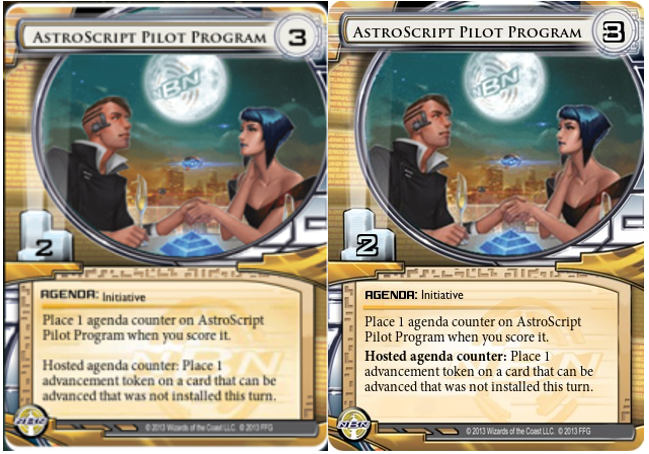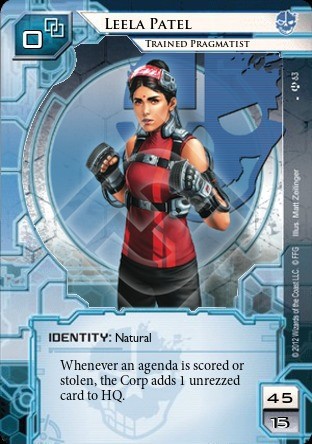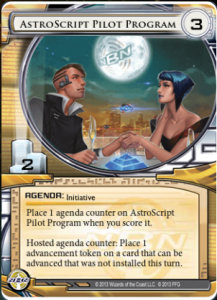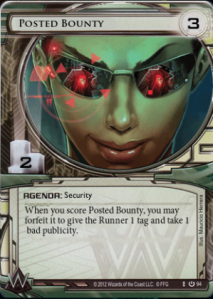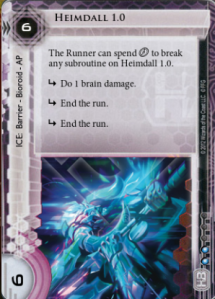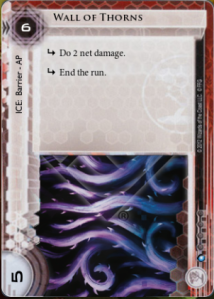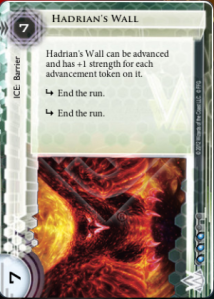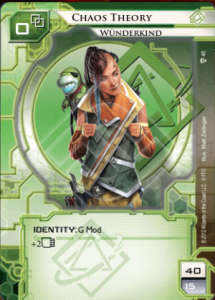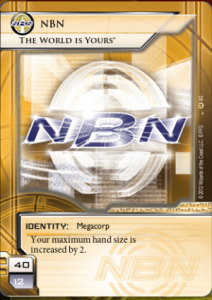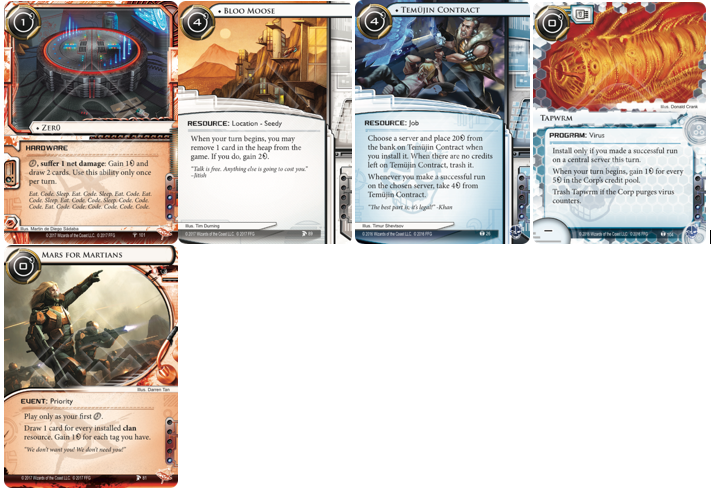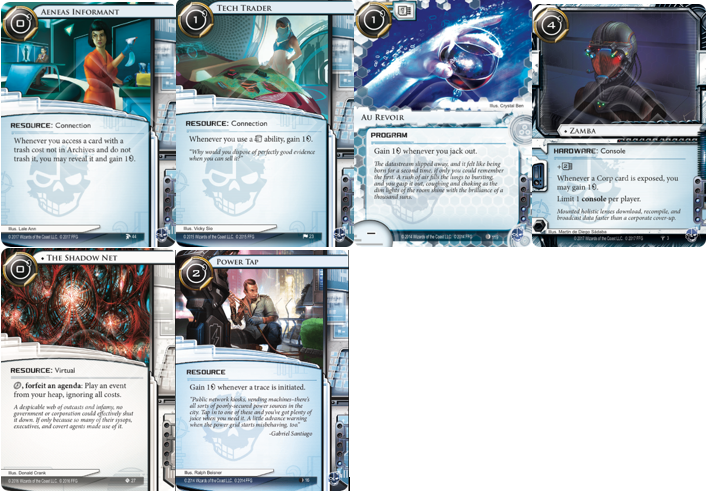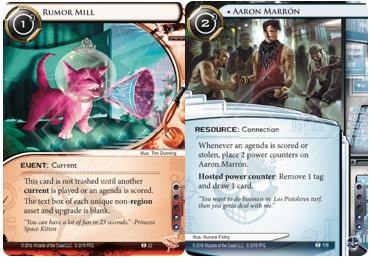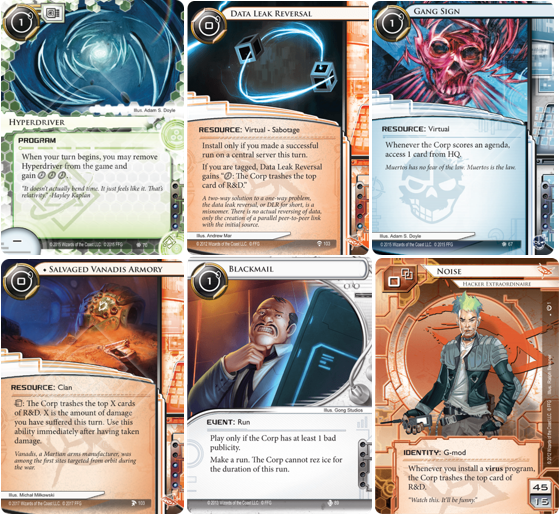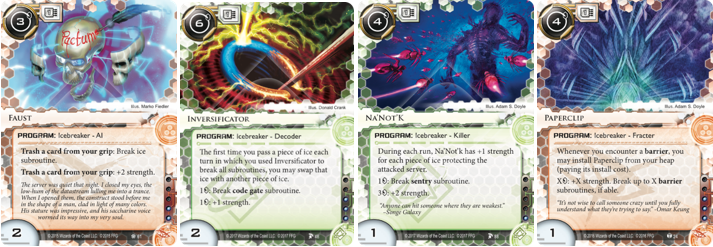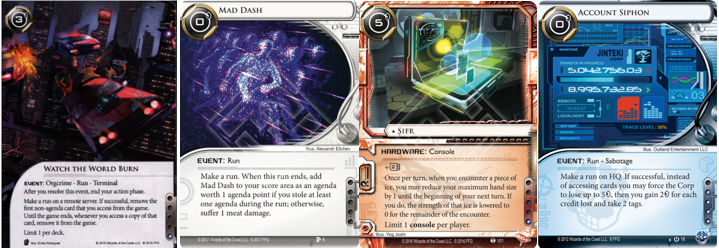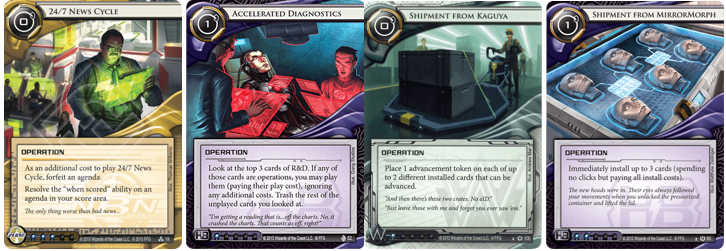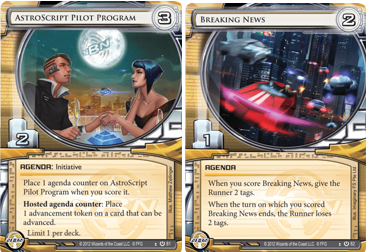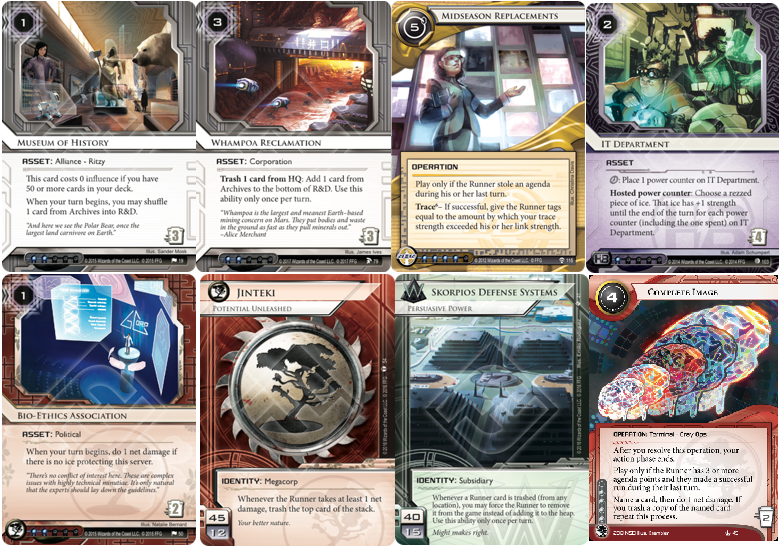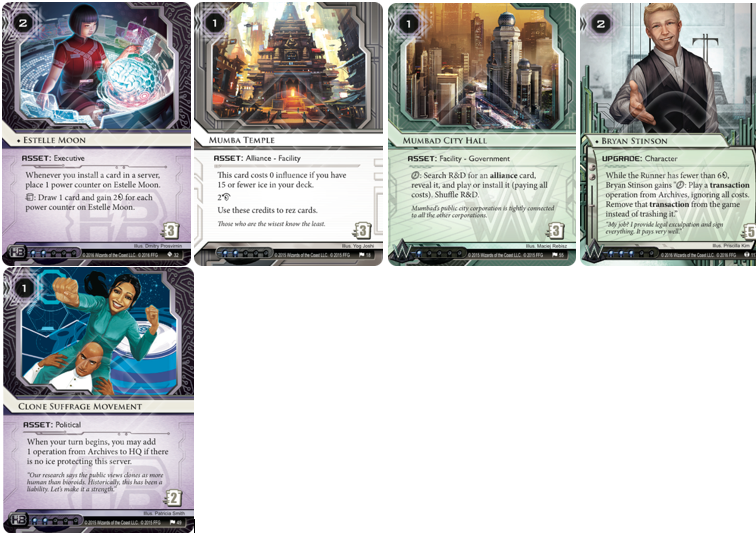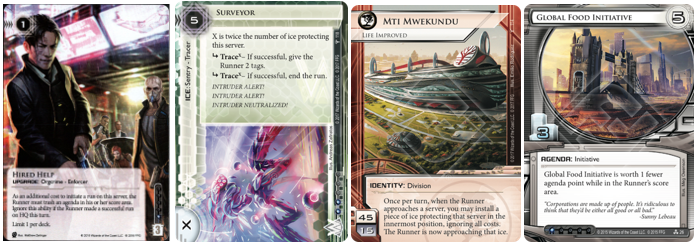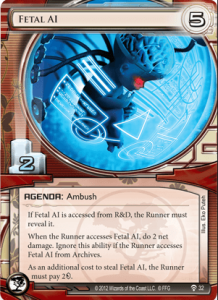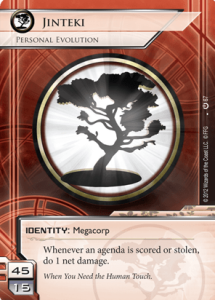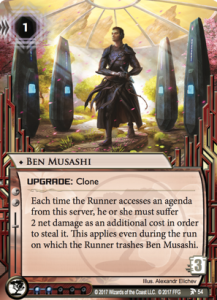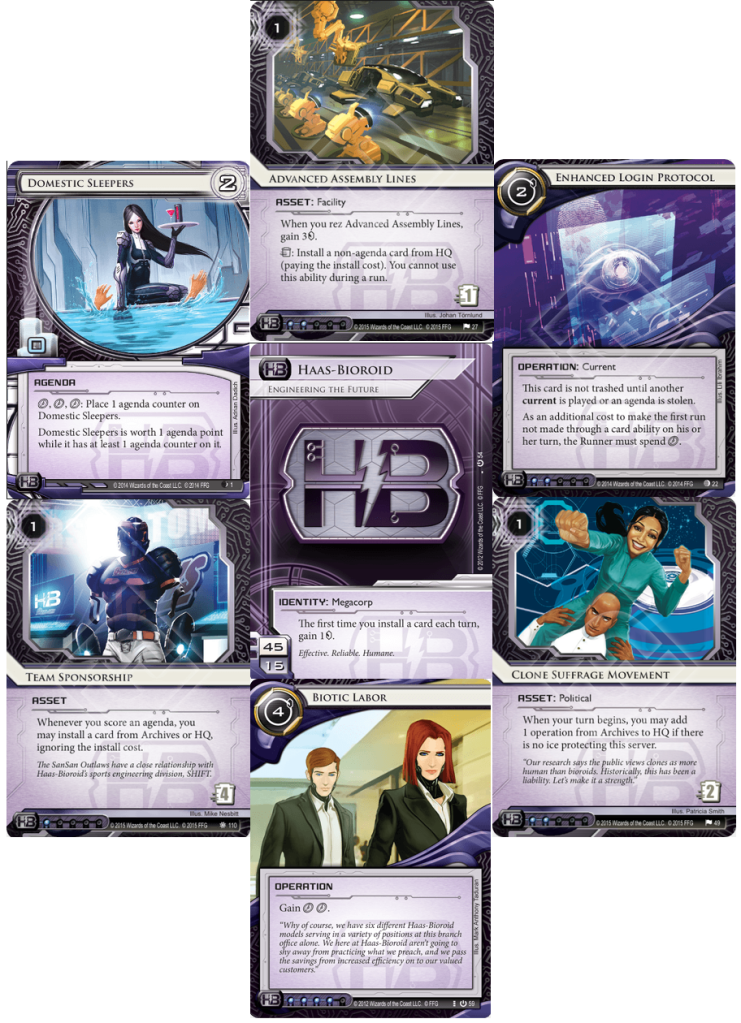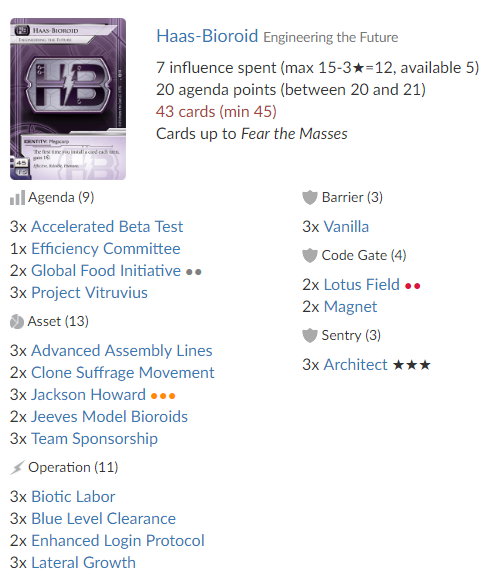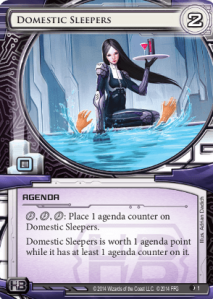As everyone who reads my content should know, I am an unwavering proponent of Fair Netrunner. For those of you who have not yet figured out that Battle of Wits was satire, it should be clear that I only champion decks that I believe embrace just and true Netrunner as it ought to be played. I often scold people for playing with Personal Evolution shell game, Blackmail Spam, CI7, and other combos and gimmicks. It is my belief that the death of a game comes when players feel that to be competitive they must subvert one or more facet of the game’s core mechanics.
There has been much debate in the community lately around what makes a deck fair or unfair, overpowered or not, or if fairness and power even have anything to do with each other. I like to think of fair and Unfair decks as components of a meal. The fair decks are the meat and potatoes, the Unfair ones are the spices and seasoning. You need some unfair decks to keep things interesting and exciting, but with no fair component, a Meta just becomes an unpalatable mound of spice. Additionally, some spices are just too strong or aggressive for most people, and the presence of even one of these can ruin the whole dish.
For this reason, I think a good rule of a healthy, diverse meta is:
There should be numerous options for unfair strategies, but they should all be limited in their unfairness. There must always be multiple fair options for each side at the top tier of competitive play.
What makes a deck unfair?
The unfair decks are the ones that provoke these reactions from their opponents:
“How am I supposed to stop that?”
“I didn’t feel like anything I did mattered.”
“My decisions felt pretty random this game.”
“I didn’t feel like I had any control over how this game went.”
“I don’t think I could win after how the first few turns went.”
“Do you ever run?/Do you ever try to score out?”
“Do you even have any Ice/Icebreakers in that deck?”
“Don’t show that to a new player, they might get the wrong impression about the game.”
“That didn’t feel like Netrunner…”
I’ve tried to take the emotions behind these statements and concretize them into a few core tenets of the game. These are statements about how the game should be played so that it feels fair and pure. Remember that violating one of these is OK, just so long as a deck does not do so to an unacceptable extent, and that multiple competitive options exist that do not violate any.

Non-Interactivity is Unfair
The most impactful plays should involve decisions made by both players. You should feel like you care what your opponent does on their turn and they should care about what you do on yours.
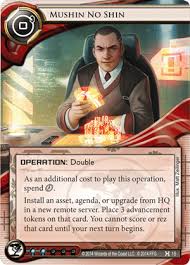
High Impact Hidden Information is Unfair
Players should be able to use hidden information to create advantages, but a single piece of hidden information should be limited in its impact, especially if high impact instances can be created frequently.
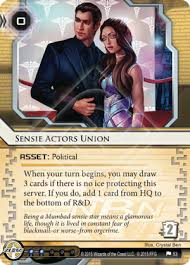
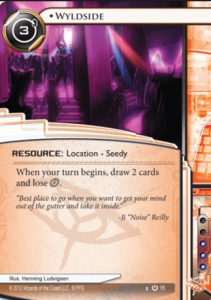
High Variance, Especially Early in the Game, is Unfair
Players should be able to make meaningful decisions and leverage their skill before a random occurrence determines or strongly influences the outcome of the game. Opening hand strength should be of minimal importance.
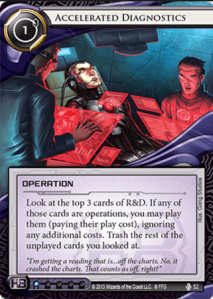
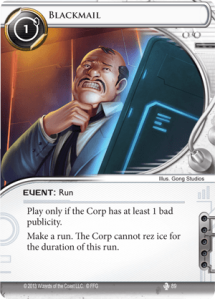
Ignoring Large portions of card-types/game actions is Unfair
Players attempting to play a simple strategy should not feel like their deck contains an overwhelming number of useless cards. Players should feel like, although some cards are more effective against a given strategy than others, most of their deck will be relevant every game. Corp decks should, to some extent, attempt to protect servers and score agendas. Runner decks should attempt to make runs and steal agendas.
To illustrate these metrics, I will now go through several competitive archetypes that have been present in the game over the last 2 years, rating each of them. I accept that my ratings are purely executive and that you may disagree by 1 point here or there, but this should still give some semblance of objectivity to the question of whether a deck is unfair. I also know that I have not covered every competitive deck, but I leave it as an exercise for you to rate whatever you feel I’ve left out for yourself.
For each category above, I will give a rating of 1 to 4 for each deck:
1: Acceptable
2: Potentially Frustrating
3: Often Frustrating
4: Unhealthy
Totaling the 4 categories gives the deck’s overall rating:
7 or Lower: Fair (We need at least a few of these to be viable for each side)
8-10: Unfair (These are OK, if they are not obviously better than all fair options)
11 or Higher: Too spicy (These decks can exist, and are cool to see occasionally, but should never be commonplace at top tier play. When one makes the cut, we should feel excited by it as a rare occurrence, not roll our eyes saying “not again…”)
Remember that these final categorizations are still based on a spectrum. A deck coming in at a 7 may still feel unfair to many players, whereas a deck coming in even as high at 10 may seem fair to those with a high tolerance. These are just rough guidelines.
Corp Side
24/7 Boom SYNC
A 24/7 combo deck that tags and kills the runner without a trace (or even a run), while hiding behind extremely difficult to handle tag ice. Essentially never scores non-2/1 agendas.
Non-interactivity – 4
Impact of Hidden information – 2
High Variance, Especially Early in the Game- 1
Large portion of card-types/game actions ignored – 4
Verdict: Too Spicy
Power Shutdown Boom Combo
A Combo deck that uses Power Shutdown, Accelerated Diagnostics, and 24/7 to Boom the runner extremely quickly.
Non-interactivity – 4
Impact of Hidden information – 3
High Variance, Especially Early in the Game- 2
Large portion of card-types/game actions ignored – 4
Verdict: Too Spicy
CtM Tempo Tag
A rush/tempo deck that uses the pressure of must-trash assets alongside the Controlling the Message ID to keep the runner at bay while it rushes agendas and disrupts the runner’s board and credit pool with Breaking News.
Non-interactivity – 1
Impact of Hidden information – 1
High Variance, Especially Early in the Game – 4
Large portion of card-types/game actions ignored – 2
Verdict: Unfair
Mushin PE
Uses Mushin No Shin to create high-variance situations that are weighted to favor the Corp. Attempts to hold off central server pressure with the threat of a net-damage flatline.
Non-interactivity – 2
Impact of Hidden information – 4
High Variance, Especially Early in the Game – 2
Large portion of card-types/game actions ignored – 3
Verdict: Too Spicy
Russian NEH
An extremely fast Near-Earth Hub deck that uses Team Sponsorship to chain agenda-scores together, and a multitude of assets to stress the runner’s clicks and early-game economy.
Non-interactivity – 2
Impact of Hidden information – 1
High Variance, Especially Early in the Game – 3
Large portion of card-types/game actions ignored – 1
Verdict: Fair
CI 7-Point Shutdown
A Combo deck that uses Power Shutdown and Accelerated Diagnostics to score 7 points in a single turn.
Non-interactivity – 4
Impact of Hidden information – 3
High Variance, Especially Early in the Game – 2
Large portion of card-types/game actions ignored – 4
Verdict: Too Spicy
Astrobiotics (Historical, Post Clot, Pre MWL)
A rush deck that uses Biotic Labor and Sansan City Grid to safely Fast Advance an Astroscript Pilot Program, chaining into more Astroscrips for a quick and inexpensive 7 points, often without ever putting Ice on a remote server. Thought to be too fast and resilient.
Non-interactivity – 3
Impact of Hidden information – 2
High Variance, Especially Early in the Game – 3
Large portion of card-types/game actions ignored – 2
Verdict: Unfair (Pre-clot this deck certainly scores far higher)
Standard Palana Foods
This deck leverages the interaction of Caprice Nisei and Nisei Mk 2 to create a very secure remote server powered by the reliable economy provided by the Palana Foods identity and high impact operations.
Non-interactivity – 2
Impact of Hidden information – 1
High Variance, Especially Early in the Game – 1
Large portion of card-types/game actions ignored – 1
Verdict: Fair
Foodcoats
Uses Breaker Bay Grid + HB Campaigns to generate a huge amount of money to rez several mid-range ice and score out with Ash and/or Caprice.
Non-interactivity – 1
Impact of Hidden information – 1
High Variance, Especially Early in the Game – 2
Large portion of card-types/game actions ignored – 1
Verdict: Fair
HB Fast Advance
Uses never-advance tactics and burst economy to sneak out 1-2 agendas, then closes the game with Biotic Labor.
Non-interactivity – 1
Impact of Hidden information – 1
High Variance, Especially Early in the Game – 1
Large portion of card-types/game actions ignored – 1
Verdict: Fair
RP Glacier
Use the economy engine of Sundew to rez several pieces of taxing ice, eventually scoring out with the Caprice Nisei + Nisei Mk2 Combo that makes a remote server nearly impossible to access.
Non-interactivity – 1
Impact of Hidden information – 1
High Variance, Especially Early in the Game – 1
Large portion of card-types/game actions ignored – 1
Verdict: Fair
Blue sun Bootcamp Glacier
A Glacier deck that uses the economy engines of Oversight AI and Adonis Campaign to create an extremely taxing Ash server that the runner cannot afford to run more than once. Often audibles into a rush strategy against decks that it cannot tax in the late-game.
Non-interactivity – 1
Impact of Hidden information – 1
High Variance, Especially Early in the Game – 2
Large portion of card-types/game actions ignored – 1
Verdict: Fair
IG 54 (Historical, although MUCH weaker versions are still being attempted)
A prison deck that uses Mumbad City Hall to repeatedly search for assets and Heritage committee, allowing it to quickly assemble a lock of Bio-Ethics Associations and Hostile Infrastructures protected by the Industrial Genomics ability. Thought to be too powerful, unfun, and non-interactive.
Non-interactivity – 4
Impact of Hidden information – 2
High Variance, Especially Early in the Game – 2
Large portion of card-types/game actions ignored – 4
Verdict: Too Spicy
IG49
A combo kill deck that uses a combination of Psychic Field, Ronin, Bio-Ethics Association, and Chairman Hiro to flatline the runner. The Industrial Genomics ability forces the runner to spend clicks and cards building credits, rather than just checking every new server for kill pieces.
Non-interactivity – 1
Impact of Hidden information – 2
High Variance, Especially Early in the Game – 2
Large portion of card-types/game actions ignored – 3
Verdict: Unfair
Runner Side
Blackmail Spam Valencia
A control deck that uses Blackmail and Rumor Mill to lock the Corp’s remote while it sets up large Medium digs. Often played with Account Siphon as well to create another angle of attack.
Non-interactivity – 3
Impact of Hidden information – 2
High Variance, Especially Early in the Game – 1
Large portion of card-types/game actions ignored – 4
Verdict: Unfair
Dyper
A Kate deck that uses the Ddos, False Echo combo along with 3 Hyperdrivers to Keyhole the win in a single turn.
Non-interactivity – 4
Impact of Hidden information – 1
High Variance, Especially Early in the Game – 3
Large portion of card-types/game actions ignored – 4
Verdict: Too Spicy
Andysucker
A tempo-oriented Criminal deck that uses the Anarch Icebreaker suite to invalidate cheap ice, and economic pressure to keep larger ice from being rezzed.
Non-interactivity – 1
Impact of Hidden information – 1
High Variance, Especially Early in the Game – 1
Large portion of card-types/game actions ignored – 1
Verdict: Fair
AggroCrim
Aggressive criminal, played usually out of Gabe but possibly out of Andy or Ken, that Siphons aggressively and floats tags against all Corps with no punishment. Aims to keep the Corp in the early game until it can score 7 points, often with no solid plan for late-game.
Non-interactivity – 1
Impact of Hidden information – 2
High Variance, Especially Early in the Game – 2
Large portion of card-types/game actions ignored – 1
Verdict: Fair
SiphonWhiz/Hate Bear
Use Ddos and Faust to land early Account Siphons, crippling the Corp and pounding them with Medium digs before they can set up a board-state that can stop the momentum of Obellus-power Faust runs.
Non-interactivity – 1
Impact of Hidden information – 1
High Variance, Especially Early in the Game – 4
Large portion of card-types/game actions ignored – 3
Verdict: Unfair
Temujin/Reg-ass Whizzard
Uses Temujin Contract to build credits quickly and Anarch Icebreakers with Datasucker and Ice Carver to invalidate most problematic ice.
Non-interactivity – 1
Impact of Hidden information – 1
High Variance, Especially Early in the Game – 1
Large portion of card-types/game actions ignored – 1
Verdict: Fair
Dumblefork
Uses Whizzard and a critical mass of Ice destruction to continually rewind the Corp’s board-state. Powered by the Wyldside Adjusted Chronotype draw engine and Faust as essentially its only breaker.
Non-interactivity – 1
Impact of Hidden information – 1
High Variance, Especially Early in the Game – 3
Large portion of card-types/game actions ignored – 3
Verdict: Unfair
Stealth Shaper
Played out of Smoke or Kate, this deck aims to set up a stealth rig powered by recurring credits, allowing it to break into either the remote, R&D, or both, for close to 0 credits.
Non-interactivity – 2
Impact of Hidden information – 1
High Variance, Especially Early in the Game – 1
Large portion of card-types/game actions ignored – 1
Verdict: Fair
DLR Maxx
A tag-me deck that aims to break the Corp with Account Siphon recursion and close the game by installing a Data Leak Reversal set-up that the Corp cannot afford to trash.
Non-interactivity – 2
Impact of Hidden information – 1
High Variance, Especially Early in the Game – 3
Large portion of card-types/game actions ignored – 4
Verdict: Unfair
DLR Val (Historical)
Similar to DLR Maxx, but with no Wireless Net Pavilion errata in place yet, and with the additional remote pressure of Blackmail.
Non-interactivity – 3
Impact of Hidden information – 1
High Variance, Especially Early in the Game – 3
Large portion of card-types/game actions ignored – 4
Verdit: Too Spicy
Prepaid Kate (Historical)
The classic Shaper. Apply pressure to scoring servers with Self-Modifying Code, efficient specialty breakers, and burst economy. Punish Centrals with The Maker’s Eye, Legwork, or Indexing when the Corp is forced to overextend to score safely. Thought to be too flexible and universal.
Non-interactivity – 1
Impact of Hidden information – 1
High Variance, Especially Early in the Game – 1
Large portion of card-types/game actions ignored – 1
Verdict: Fair
Wyldcakes Noise (Historical)
Install “Exodia” (Wyldside, Adjusted Chronotype, and Aesop’s Pawnshop) and use the disruptive viruses it supplies and pays for to force the Corp to protect their board-state rather than score. Eventually win with Noise’s ability if the Corp does not score out quickly enough. Thought to be too difficult for the Corp to interact with.
Non-interactivity – 3
Impact of Hidden information – 1
High Variance, Especially Early in the Game – 2
Large portion of card-types/game actions ignored – 3
Verdict: Unfair
Hopes and Dreams
Now that I’ve provided a multitude of examples of fair and unfair decks, I can present my vision for a healthy Netrunner Metagame. Ideally a top 8 cut at a healthy tournament would have:
4 Fair decks (best if they are not all the same)
3 Unfair decks (better if they are all different from each other)
1 Very Spicy deck
Now let’s look at the worlds top 8 cut from 2016 and see how close we came (The tournament had a top 16, but lists are not readily available for all the decks that placed 9-16. Feel free to track them down yourself.)
Corp: 6 Unfair, 2 Spicy
Runner: 3 Fair, 5 Unfair
This is pretty far from what we would like to see. Now let’s look at 2015:
Corp: 6 Fair, 2 Unfair
Runner: 4 Fair, 2 Unfair, 2 Spicy
Even without the Most Wanted List to reign in power, and with Wireless Net Pavilion un-fixed, 2015 was a fairer Metagame than 2016 (It did still have a diversity problem, but this is easier to fix with the printing of new cards than a fairness problem). This shift happened for a few reasons. First, aside from Astroscript Pilot Program, all the cards on the original Most Wanted List were cards that enabled fair strategies! The second Most Wanted List certainly included more unfair cards like Faust and Wyldside, but the damage had already been done, since fair strategies often rely on their influence to import win-conditions, while unfair decks exist that can run on close to no influence. Second, so many powerful runner hate cards have been printed, nearly all targeting Corporation Win-conditions, that every fair deck in the game right now has at least one extremely problematic match-up. For more on this, check out Kenny Deakins’ Stimhack article on the subject:
Kenny’s Article
Conclusion
A lot of people have asked when I am going to write my next deck article and the truth is: I can’t. I have not been able to make a successful new fair deck on either side since Sleeper Hold (which is actually even better now than when I wrote about it). Until something fundamental changes about the current environment, you probably wont be hearing much from me on this platform…
I’m not here to propose that any action be taken, just to provide a foundation to have a discussion around. Can you build fair Corporation decks that can survive in the current environment? Do you agree with my assessment that the presence of fair decks is necessary to the health of the game? Do you just want me to just brew toxic nonsense and post it here? What, if anything, do you think should be done?
Thanks for reading.
-TheBigBoy
